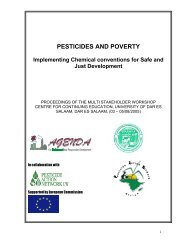Your Daily Poison - Pesticide Action Network UK
Your Daily Poison - Pesticide Action Network UK
Your Daily Poison - Pesticide Action Network UK
You also want an ePaper? Increase the reach of your titles
YUMPU automatically turns print PDFs into web optimized ePapers that Google loves.
2 Food residues<br />
PAN <strong>UK</strong> has conducted an analysis of residues<br />
both from the <strong>UK</strong> government’s testing<br />
programme (2004 results) and from the<br />
European Union testing programme (2003,<br />
latest results), identifying the occurrence of<br />
pesticides of particular concern for human<br />
health. There are serious issues about<br />
potential health effects, particularly on the<br />
unborn, babies, and toddlers. For example,<br />
recent research suggests that exposure to<br />
carcinogens in the uterus or early childhood<br />
can damage DNA and heighten susceptibility<br />
to disease later in life 15 . Children can consume<br />
a disproportionate level of pesticide residues<br />
because of their high consumption relative to<br />
their bodyweight.<br />
Europe<br />
Levels of residues in food across Europe have<br />
remained high. The latest figures from the<br />
European Commission’s monitoring<br />
programme indicate that conventionally<br />
produced food is as contaminated with<br />
pesticides as in 2002 (Appendix 5a). In a new<br />
report 16 the EC acknowledges that toxic<br />
chemicals in food are a risk to the health of<br />
children and vulnerable adults, reporting<br />
breaches of safety limits which are a significant<br />
risk to health. According to PAN Europe,<br />
‘These results show a complete failure of the<br />
EU in controlling the level of pesticides in our<br />
food 17 .’ Countries which test a relatively high<br />
number of samples, such as Germany, detect<br />
a higher number of residues. The number of<br />
samples tested per head of the population in<br />
the <strong>UK</strong> is the lowest in Europe with the<br />
exception of Portugal 18 .<br />
According to the data from the European<br />
survey, babies and toddlers are at risk from<br />
residues of some of the most acutely toxic<br />
pesticides detected in tests. At the residue<br />
levels found, a toddler could consume well over<br />
the health-based safety limit, the amount that<br />
can be safely consumed in one meal or one<br />
day, see Acute Reference Dose, ARfD, page<br />
22. This would equate to 147% of chlorpyrifos<br />
in table grapes, 164% of methamidophos in<br />
sweet peppers, over twice the limit of<br />
endosulfan, over five times the limit of<br />
triazophos in sweet peppers and a staggering<br />
ten times the limit of methomyl – 1035% – in<br />
table grapes.<br />
<strong>UK</strong><br />
The government’s <strong>Pesticide</strong> Residues<br />
Committee (PRC) runs a programme of<br />
residue testing jointly paid for by a levy on<br />
agrochemical companies and by government<br />
funding. The official source of data on<br />
pesticides used in the <strong>UK</strong> is the Central<br />
Science Laboratory’s <strong>Pesticide</strong> Usage Survey<br />
Group data 19 . This is a sample of approximately<br />
2,000 <strong>UK</strong> farms. The PRC acknowledges that<br />
‘the range of pesticides that may be used in<br />
agriculture and food production, either in this<br />
country or abroad, is very wide. About 350<br />
active substances are currently approved for<br />
use as agricultural pesticides in the <strong>UK</strong> and<br />
over 850 are approved in one or more EU<br />
states. Potentially around 1,000 different<br />
chemicals might be sought 20 .’ Yet the PRC only<br />
tested for 123 pesticides in 2004 21 .<br />
Results from the <strong>UK</strong> government’s testing<br />
programme (Appendix 5b) indicate rising levels<br />
of residues – 25 per cent of foods sampled in<br />
2003 contained pesticide residues, and the<br />
figure rose to 31 per cent in 2004. Residues<br />
below or at the legal limit (the Maximum<br />
Residue Level, see page 22) contaminated 30<br />
per cent of samples (24 per cent in 2003), and<br />
above the legal limit 1 per cent of samples<br />
(less than 1 per cent in 2003).<br />
One sample of round lettuce was found to<br />
contain inorganic bromide at between 2.9 and<br />
5.4 times the ARfD for children and adults.<br />
One sample of lettuce imported was found to<br />
contain two residues above the legal limit (the<br />
MRL, page 22) of endosulfan and<br />
methamidophos. A risk assessment for<br />
methamidophos estimated exposure at 9.3<br />
times the ARfD for children. According to the<br />
PRC, ‘Short-term negative effects on people’s<br />
health are unlikely, but sensitive children might<br />
briefly have symptoms such as sweating,<br />
producing too much saliva or stomachs’ [sic,<br />
presumably stomach ache]. One sample of<br />
imported speciality beans (yard-long beans)<br />
contained two residues above the legal limit. A<br />
risk assessment for triazophos showed that<br />
intakes for adults and infants were 1.7 and 3<br />
times the ARfD 22 .<br />
PAN <strong>UK</strong> has collated the <strong>UK</strong> data and<br />
established the known hazards to health of the<br />
residues found in it. This indicates that<br />
consumers are being exposed to pesticides<br />
the second <strong>UK</strong> pesticide exposure report 9

















